Two Approaches to Making Simplified Music Even
Simpler
Automate the chords, but not the melody strings
| This was the most common approach to zither gizmos: little gadgets
that strike or pluck a set of chord strings. This Chartola Grand is an
example of what Garry calls the "Chord
Thumper." It has 4 spring-loaded metal pedals that are raised and released
with the fingers of the left hand to strike chords. It looks nice on my
wall, but frankly, it doesn't work all that well. |
|
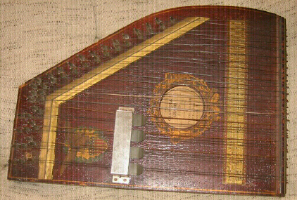
|
|
my Chartola Grand
|
|
Automate the melody strings, but not the chords
This approach is far more succesful, although trickier
(and more expensive) to implement. There were a surprising number of these
around the turn of the century, such as the Deweylin
Harp, described in the1902 Sears catalog as:
"...the wonder of the age...the greatest musical instrument that has
ever been placed before the public."
The Marxophone may have been the only one of Henry Charles
Marx's musical inventions that was truly playable. It's certainly the most
accessible - absolutely anybody can plunk out a tune on the spring-loaded
keys. Unlike the Deweylin and the fabulous Dolceola,
there's nothing chromatic about this instrument - it's strictly key of
C. All the melody strings are double strings, like a mandolin. Depending
on how one strikes the keys, the wooden hammers may produce a tinny harpsichord
sound or a mandolin-like trill. It's really fun to play. |
|
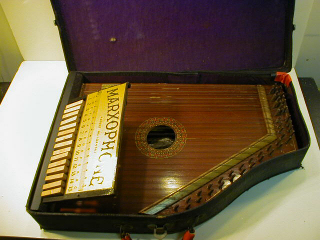
|
|
my Wooden-Key Marxophone
(Marxochime)
|
Most of the ones I've seen online have metal keys. This one has wooden
keys and wooden hammers. The hammers are mounted on metal strips, which
give the hammers their spring. For more about Marxophones, check out
Bob Lang's Marxophone
Home Page.
Fun fact: The Doors didn't have a bass player, but they did have a Marxophone,
at least for one song (that song about finding the "next whiskey bar" -
can't remember the name). |
Overdoing It - the Marxolin
(aka the Hawaii'lin)
| And, finally, a cautionary example
of what can happen when a creative mind just doesn't know when to quit.
This instrument is all gimmicks, very few of which work at all,
much less provide any improvement. In essence, this is a horribly mutated
Violin-Uke. It's still a compact little instrument with a double row of
melody strings V-ing towards each other. But what have they done to the
body? It's two, count'em, two, bodies in one, elegantly stacked on top
of each other. This must be intended to add resonance to a small instrument,
but if that was the idea, it didn't work. Neither did the double rows of
vents that replace that old-fashioned sound-hole, although they do succeed
in making the thing look more like a '30's roadster than zithers usually
do. (Of course, the classic roadster look might have been more successful
if they hadn't gotten so carried away with the airbrushed blue-green-chartreuse
finish.) |
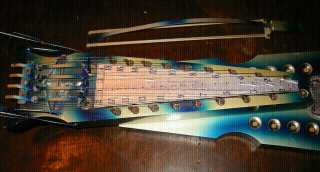
|
And look at that bow! No, you're not seeing double. This
bow has two, count'em, two bow hairs so that you can play thirds
all the time, whether you want to or not. And don't overlook the double
rosin carrier screwed to the side of the lower body, allowing you to rosin
both sides of your bow at once!
And then there's the strings. Normal zither strings
are just lengths of steel wire with a loop at one end and the other end
wrapped around a tuning peg. A little bit tedious to replace, but simple.
Not on the Marxolin. These strings have small screws soldered to the
ends so that the the strings can be adjusted with a screwdriver instead
of a tuning wrench. Which means that the strings cannot be replaced by
anything except a specially-made marxolin string (which, of course, haven't
been made for 50 years). |
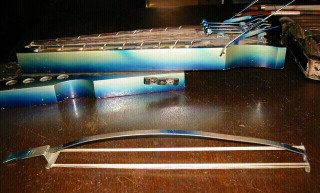 |
| But wait, we haven't even gotten to the gizmos yet!
There's metal thumpers on the top, each one cunningly shaped to hit a different
set of strings, thus eliminating the need for the chord strings. When you
whang the metal levers, they b-b-b-b-b-oinggg-g-g up and down on the
strings for that "authentic" Hawaiian steel guitar sound. And if that's
not enough, there are two strange little metal levers that you operate
with your 3rd hand, which are apparently supposed to raise the pitch of
the strings a half-step. |
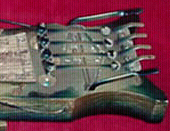 |
| All in all, this one takes the prize for the most unplayable instrument
I own, and quite possibly the most unplayable ever designed. However, I'm
not a bit sorry I bought it. It looks terrific hanging on the wall, and
people are fascinated by it. Heck, the bow itself was worth the price,
assuming that I ever decide that my Ukelin would sound twice as good if
I always played two notes instead of one with every stroke. |
|
